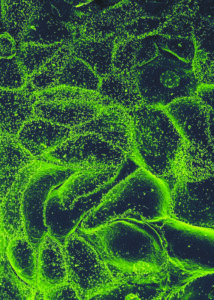
A National Institutes of Health research group with extensive experience studying ebolavirus countermeasures has successfully developed a vaccine against Sudan virus (SUDV) based on the licensed Ebola virus (EBOV) vaccine. SUDV, identified in 1976, is one of the four viruses known to cause human Ebolavirus disease. The new vaccine, VSV-SUDV, completely protected cynomolgus macaques against a lethal SUDV challenge. The findings were published in the journal The Lancet Microbe. [DOI: 10.1016/S2666-5247(23)00001-0 (2023)]
SUDV is distinct from and less common than EBOV, but similarly deadly. A recent four-month SUDV outbreak in Uganda that ended on Jan. 11, 2023, caused 142 confirmed cases and 55 deaths. No treatment or vaccine for SUDV disease is licensed, although candidates are in clinical and preclinical trials. One of these candidates is VSV-SUDV, developed and tested by scientists at NIH’s National Institute of Allergy and Infectious Diseases in Hamilton.
Dr. Andrea Marzi, lead author of the study published in The Lancet Microbe, said that there were two aims to the latest study.
“One was to test if our Sudan Virus vaccine would protect from disease and lethality,” said Dr. Marzi. “The second was to investigate if a previous vaccination to the Ebolavirus Vaccine, which is different but is also an ebolavirus, would have any benefit or contrasting effect on vaccination and protection with our vaccine.” The reason for the second aim,” she said, “was Uganda, where there was an Ebola outbreak before and now there is a Sudan Virus outbreak. So, we want to know if we go in and vaccinate people with the Sudan vaccine or the Ebola Vaccine what the effect is on the infection.”
The live attenuated vector vaccine uses genetically engineered vesicular stomatitis virus (VSV), an animal virus that primarily affects cattle, to express a SUDV protein as a single-dose vaccine. The researchers developed VSV-SUDV using techniques that led to Ervebo, the VSV-EBOV vaccine that the European Medicines Agency and the U.S. Food and Drug Administration approved in 2019 as the first vaccine for the prevention of Ebola virus disease. In the current studies, the investigators replaced the key EBOV protein in Ervebo with the comparable protein from SUDV.
Next, the researchers tested the safety and efficacy of VSV-SUDV in macaques. The study involved 11 animals, each of which had previously received the EBOV vaccine and then rested for nine months. Six macaques were vaccinated with VSV-SUDV and five control animals were vaccinated with VSV-MARV, a vaccine candidate in development for Marburg virus. After 28 days, during which no animals showed adverse effects from the vaccines, they were challenged with a lethal dose of SUDV. None of the animals vaccinated with VSV-SUDV showed any signs of disease, but four of the five control animals developed clinical signs of Sudan virus disease.
According to Dr.Marzi, the surviving control animal, which responded similarly to the vaccinated animals, surprised the scientists and might indicate some cross-protective immune responses in this animal. She said future studies should support or disprove this finding.
The fact that four control animals got sick demonstrates that pre-existing immunity to EBOV and VSV-EBOV has limited effect on protection from SUDV. But the main take-away from the study is that the Sudan Virus Vaccine prevents the disease in animals.
Dr. Marzi began working with Dr. Heinz Feldmann, the developer of the VSV used in the first Ebola Virus Vaccine, at Canada’s National Microbiology Laboratory. She followed him to Montana when he relocated to Rocky Mountain Laboratory and was among the group of RML scientists that went to Liberia, Africa during the Ebola Virus outbreak there in 2015. She said that the first successful animal trials for the Ebola vaccine took place in 2005 but the vaccine was not licensed to be used until November of 2019.
“Licensing a vaccine for use is not a quick process,” said Dr. Marzi. “Disappointingly, the situation with vaccines and treatment options against Ebolaviruses in general has barely changed since the EBOV epidemic in west Africa more than eight years ago.”
Today six distinct species belonging to the genus Ebolavirus have been described, of which Zaire, Sudan, Bundibugyo, and Taï Foreste ebolaviruses are known causes of human hemorrhagic disease.
SUDV, the single virus member in the Sudan ebolavirus species, was co-discovered with EBOV in 1976 during an outbreak of viral hemorrhagic disease. It re-emerged in South Sudan in 1979 and 2004, causing smaller Sudan virus disease outbreaks. In 2000–01, SUDV emerged in Gulu, Uganda, causing the largest Sudan virus disease outbreak on record, with 425 cases and a case fatality rate of 53%. This emergence was followed by smaller outbreaks in Uganda in 2011, 2012, and 2012–13.
“The recent Sudan virus (SUDV) outbreak in Uganda,” said Dr. Marzi, “highlights the need for rapid response capabilities, including development of vaccines against emerging viruses with high public health impact. We aimed to develop a Sudan virus-specific vaccine suitable for emergency use during outbreaks.”
According to Dr. Marzi, even emergency use must get authorization from the Food and Drug Administration and the World Health Organization as well as the approval of authorities in the country in which the vaccine might be used.